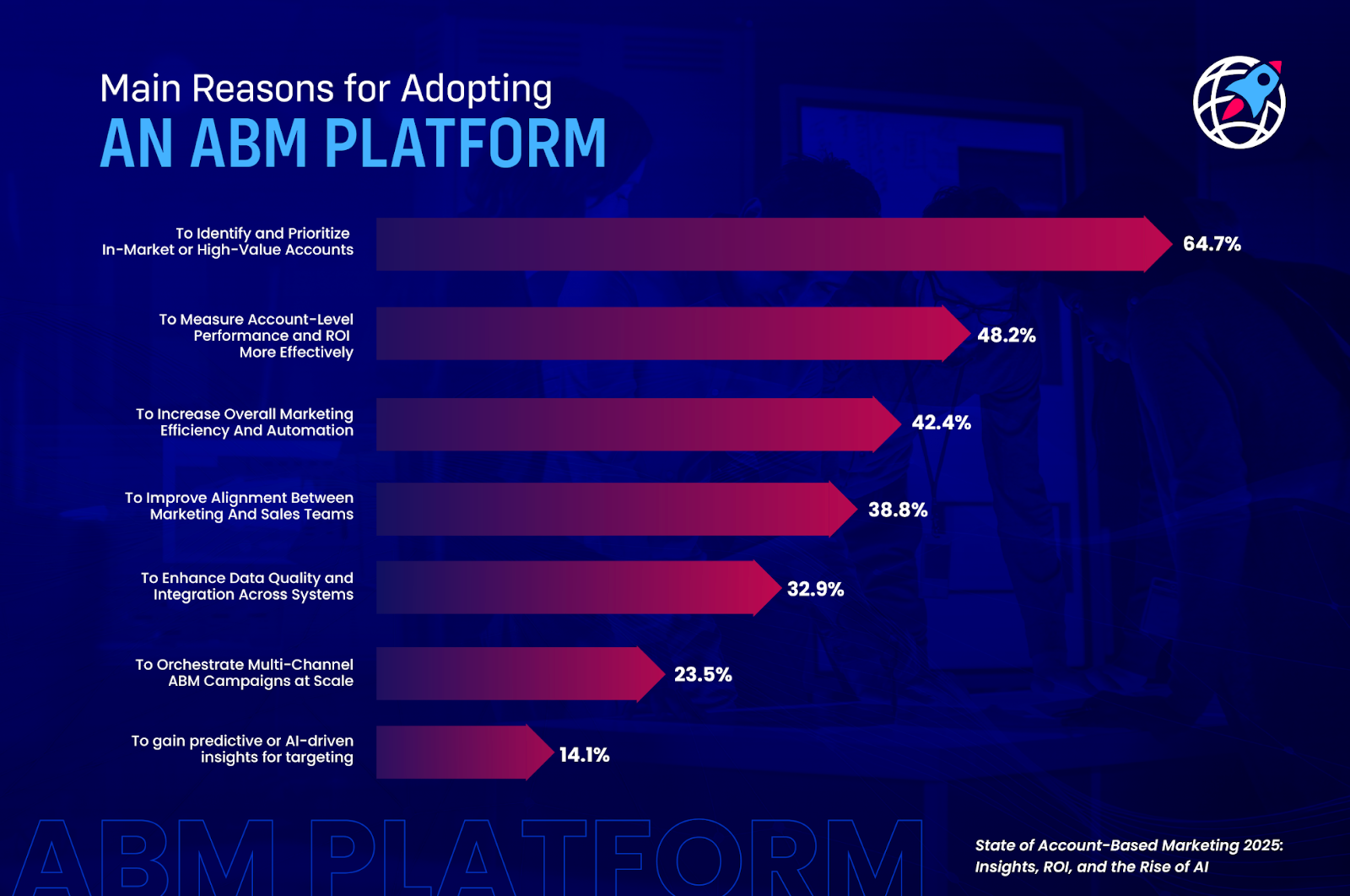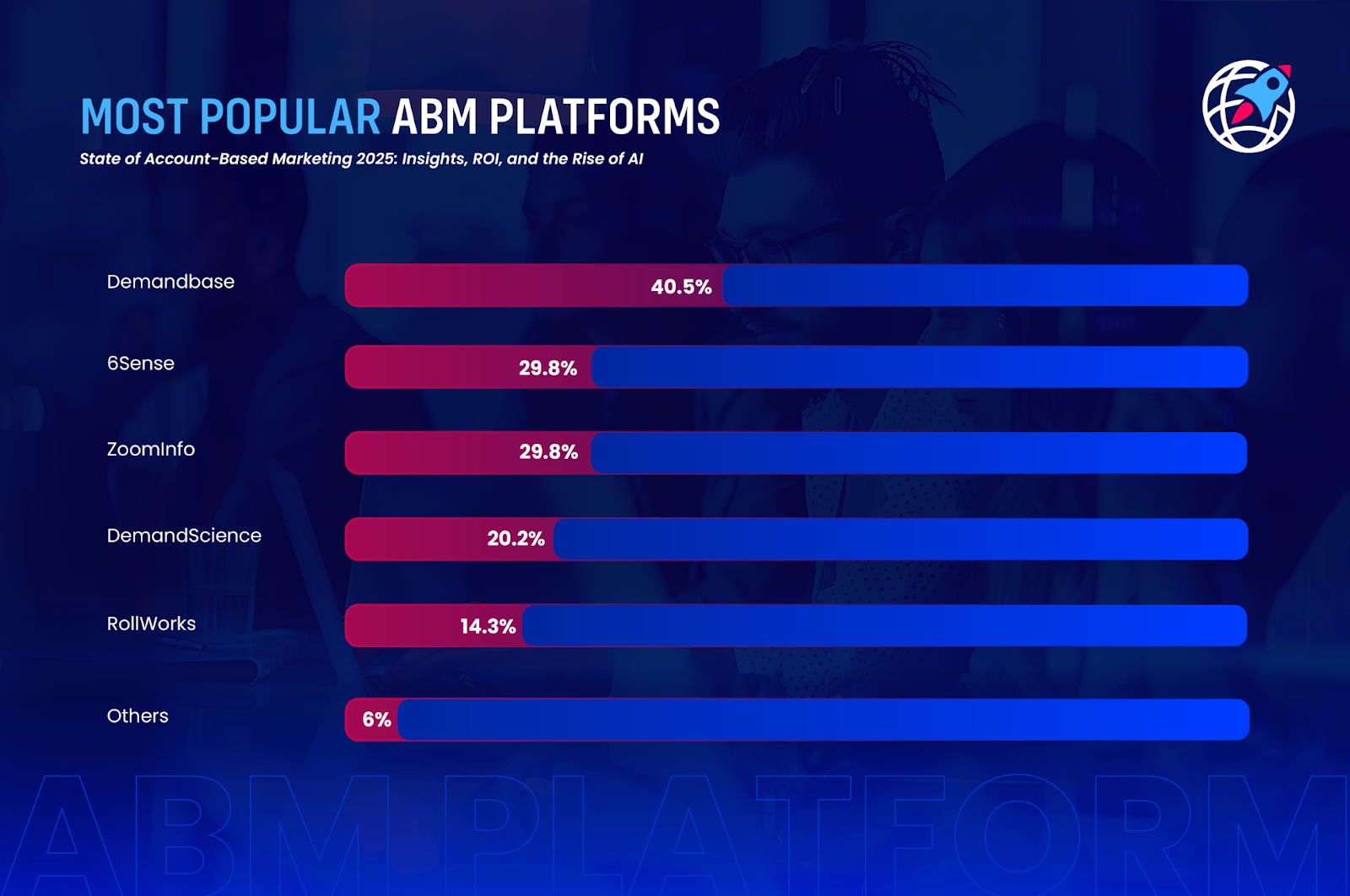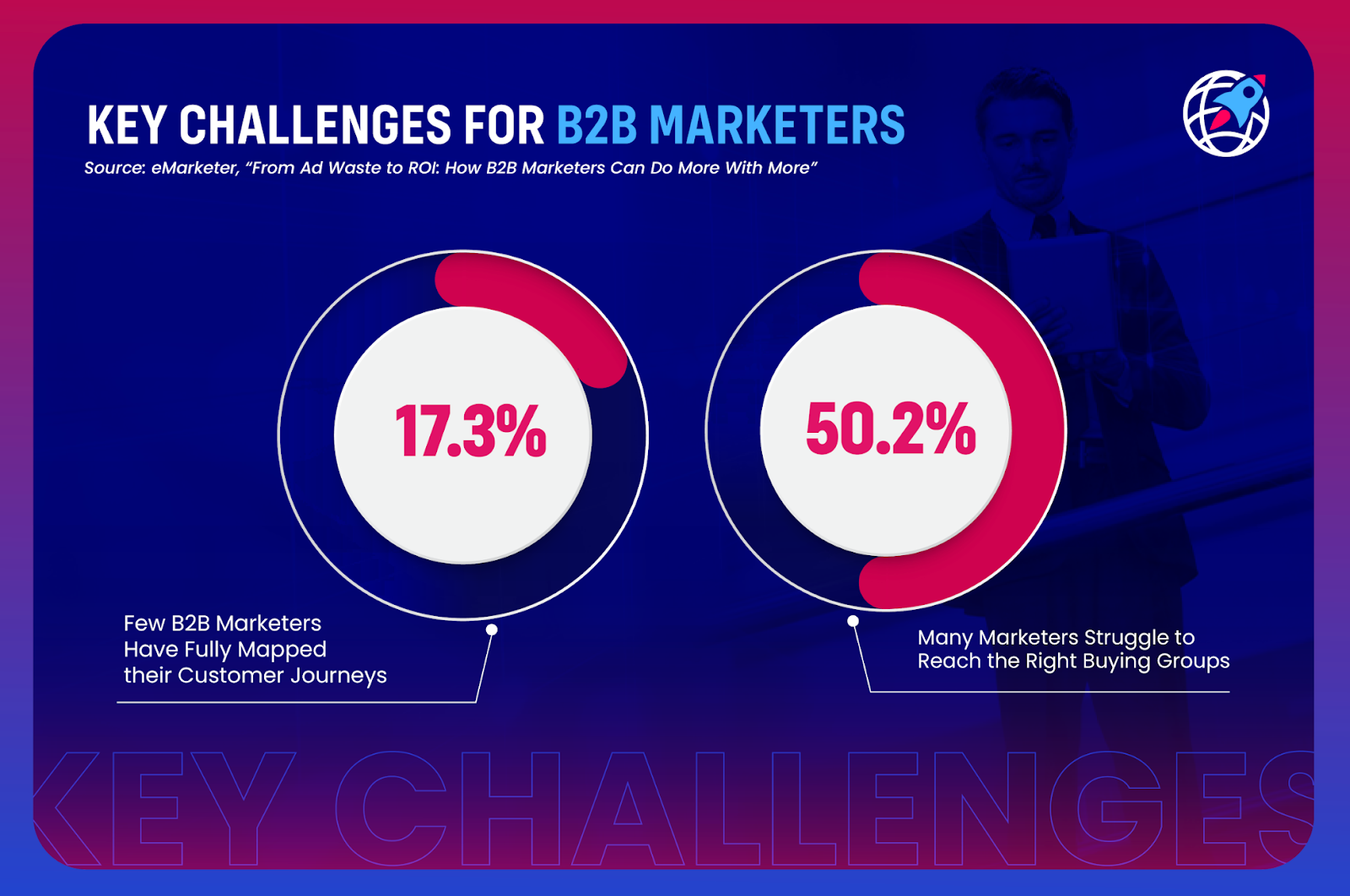State of Account-Based Marketing 2025: Insights, ROI, and the Rise of AI

As 2025 comes to an end, Account-Based Marketing (ABM) is more dynamic than ever. Organizations are working in a landscape where personalized engagement, measurable ROI, and AI-driven automation are no longer optional but expected.
Our report surveys 771 marketers, reflecting the state of ABM in 2025, highlighting new trends, investment priorities, and the role of AI in scaling campaigns. It will also serve as a valuable resource for marketers planning their strategies for 2026, providing insights to help organizations stay ahead in an increasingly competitive digital environment.
Key Findings
- 71.2% of organizations currently implement ABM strategies.
- The estimated average ROI from ABM programs is 137%, with nearly half of organizations citing ABM as delivering the highest ROI.
- 78.7% of companies incorporate AI into ABM, mainly for personalization, predictive analytics, and targeting.
- 40.3% of organizations plan to invest in ABM 2.0 capabilities within the next 12 months.
- 49.7% of organizations plan to increase ABM budgets in 2026.
- 86.2% of respondents expect AI to boost ABM ROI over the next year.
Who’s Driving Account-Based Marketing
Based on the responses, there is a diverse representation of both marketing professionals and company sizes, indicating that ABM development must be customized across different experience levels and operational scales.

The above distribution reveals the need for ABM insights to serve a wide range of marketers across various organizational sizes. This is a key consideration for strategies that will be effective in 2026 and beyond.
Driving Results with ABM
Account-Based Marketing has firmly established itself as one of the pillars of modern B2B marketing strategies. Among them, in 2025, 71.2% of organizations have started actively using ABM strategies.
The outcomes are self-explanatory. Almost every respondent (99.3%) says their ABM efforts are successful, with 38.6% of respondents' organizations reporting significant returns as very successful. Of these respondents, nearly half (49.2%) reported that ABM was the highest source of ROI for their organization, and the estimated average ROI generated by ABM programs in these respondents' organizations was an impressive 137%.
ABM outperforms traditional marketing strategies. Eighty-two percent of organizations reported that ABM delivers a higher ROI than conventional initiatives, with 20.9% achieving a more than 50% increase over traditional methods. The Salesforce 9th Edition of the State of Marketing Report even showed that 78% of organizations are using ABM for customer acquisition, anchoring the critical impact of ABM in driving customers to the brand and retaining them.
How ABM Drives Marketing Success
Marketers cite a variety of ways ABM contributes to organizational growth.
.jpg)
The most common impact is from increased revenue (64.1%), followed by improved engagement with the right customers (59.4%). Other interesting benefits are increased win rates (51.5%), improved marketing ROI (51.0%), more leads (48.5%), and larger deal sizes (34.8%). A lower proportion, 15.7%, reported that their deals were accelerated, and only 0.5% reported other benefits.
ABM Investment
Organizations are placing their money where the results are. On average, 27% of marketing budgets are allocated to ABM, underscoring its importance in driving measurable and high-impact results.
These insights demonstrate that ABM is not a trend, but an established growth engine, providing a clear ROI and setting organizations up for further success as they look ahead to 2026.
Adoption and Use of ABM Platforms
While ABM has proven its value, the adoption of ABM platforms is varied. Only 15.3% of organizations are currently utilizing a dedicated ABM platform, such as Demandbase, 6sense, DemandScience, or RollWorks, to run their programs. The majority (56.1%) use a combination of different tools, such as CRM, marketing automation, and intent data, but not a specific platform. Meanwhile, 19.9% implement ABM manually with internal resources, and a smaller percentage (8.7%) partner with agencies to run their programs.
Barriers to Platform Adoption
Cost is the primary reason for organizations' hesitation in implementing a dedicated ABM platform, as mentioned by 48% of respondents. Other challenges include limited internal resources (34.2%) and implementation complexity (31.6%), which means that even those who want to adopt ABM may find it difficult to deploy platforms correctly. Additionally, 27.7% are happy with their existing tools, and 22.8% are unaware of available ABM solutions. To close this gap among the unaware, service providers should heavily lean on significantly increased ROI as the primary outcome of ABM and organize more workshops to increase the adoption rate.

Drivers for Adopting ABM Platforms
Among the organizations that have implemented an ABM platform, the number one reason is to identify and prioritize in-market or high-value accounts (64.7%). Nearly half (48.2%) wanted to measure account-level performance and ROI more effectively, and 42.4% sought to be more efficient and automated in their marketing efforts.

Other key drivers were to better align marketing and sales teams (38.8%) and to improve data quality and integration between systems (32.9%).
Meanwhile, 23.5% were using ABM platforms to execute multi-channel campaigns at scale, and 14.1% were driven by the desire to gain predictive or AI-driven insights for targeting.
Platform Preferences
When it comes to specific platforms, Demandbase is the market leader, used by 40.5% of the respondents, closely followed by 6sense and ZoomInfo (both with 29.8%). DemandScience is used by 20.2%, while RollWorks is used by 14.3%.
This distribution not only demonstrates the dominance of the established ABM platforms but also the variety of approaches organizations use, including fully integrated platforms, hybrid or manual approaches, based on their budget, resources, and strategic priorities.

AI Trends in Account-Based Marketing
Artificial intelligence (AI) is fast becoming a cornerstone of modern ABM strategies. In 2025, 78.7% of organizations are utilizing AI in their ABM programs, which can be leveraged for personalization, predictive analytics, and more precise targeting. Among those surveyed, 15.1% of users utilize AI to a large extent, and 63.6% use it to a more limited extent, indicating that the adoption of AI is widespread but still in development.
Key Benefits of AI in ABM
Marketers are reporting diverse benefits to be gained from AI integration, with the most common one being enhanced targeting and segmentation of accounts (48.5%).
Other uses of AI included improving efficiency in lead engagement (36.4%), campaign copy and messaging generation through AI tools (36.2%), refining buyer personas and identification of key pain points (32.1%), persona segmentation (31.7%), forecasting of deal outcomes (29.0%), and win rates through data-driven insights (26.0%).

These results are a proven number of how AI is not just a buzzword in ABM. It is actively revolutionizing targeting precision, campaign personalization, and decision-making. While some organizations are still exploring the potential of AI, most are already seeing positive outcomes in terms of engagement, efficiency, and improvement.
The Next Generation: ABM 2.0
B2B marketers face persistent challenges: only 17.3% have fully mapped their customer journeys, and 50.2% struggle to reach the right buying groups, according to eMarketer. These gaps highlight the need for advanced account-based strategies that go beyond traditional ABM.

ABM 2.0 addresses these challenges by focusing on hyper-personalization, AI adoption, and cross-channel alignment, enabling organizations to improve targeting, engagement, and measurable outcomes. Nearly half of respondents (47.7%) are familiar with ABM 2.0, while 38.4% are not familiar but would like to learn more.
Looking forward, 40.3% of organizations plan to invest in ABM 2.0 capabilities within the next 12 months, indicating strong momentum for adopting advanced ABM technologies.

Looking Ahead: Account-Based Marketing in 2026
As organizations plan for the year ahead, their top ABM priorities reflect a focus on ROI, AI, and scaling effectiveness.
The key priority is realizing a higher ROI than currently (54.3%), followed by more integration with AI and automation (51.0%), growth in deal sizes and win rate (34.8%), moving into new markets or accounts (33.7%), and the implementation of ABM 2.0 practices (28.4%). Other priorities included increased engagement with ideal customers (25.3%) and addressing existing challenges, such as budget or measurement issues (21.7%).

Reflecting this momentum, 49.7% of organizations plan to increase their ABM budgets in 2026, showing that they are becoming increasingly confident with the account-based approach to generate revenue, engagement, and measurable ROI. Moreover, 86.2% of organizations anticipate that AI will improve ABM ROI in the past year, highlighting the transformative power of intelligent automation and data-driven decision-making.

Conclusion
In 2025, ABM has reached a state of maturity, with high adoption, a very good ROI, and AI becoming a key lever of success. Organizations are beginning to look beyond traditional ABM and are exploring ABM 2.0 capabilities as well as how to incorporate advanced technologies to personalize engagement at scale.
As we head into 2026, the pillars remain: maximize ROI, leverage AI, improve account coverage, and introduce a new pillar – adopting ABM 2.0 practices. For marketers, this report serves as both a benchmark of current success and a blueprint for achieving success next year. ABM is a growth engine that, when executed with precision and intelligence, can deliver measurable and sustainable results.
Methodology
The survey was conducted in October 2025 via Prolific, with 771 marketers from diverse industries, roles, and organization sizes participating. The results offer a comprehensive view of current account-based marketing (ABM) practices and trends.

Accelerate Your
Growth
& Market Impact
Our healthcare growth teams works closely with you to design strategies tailored to your unique goals and market dynamics, fully focused on growth.
